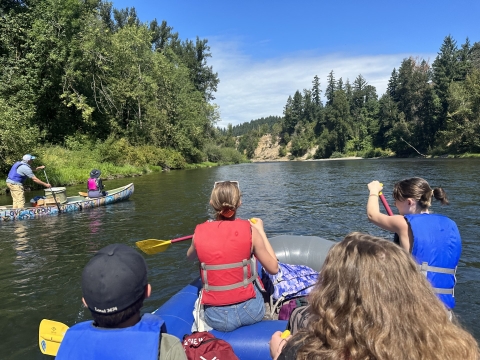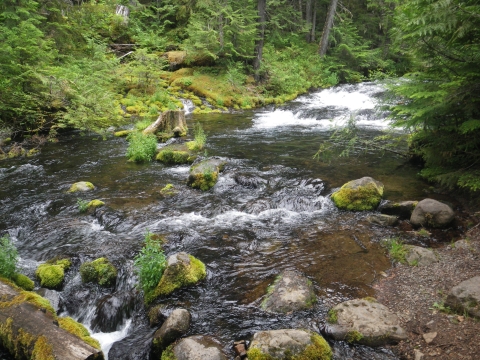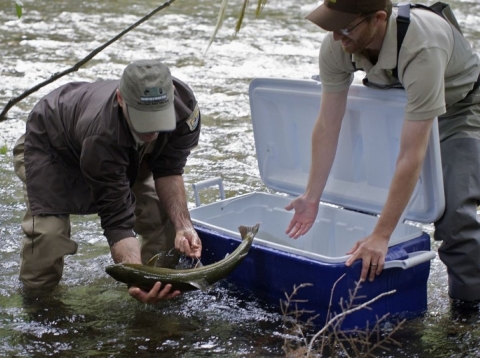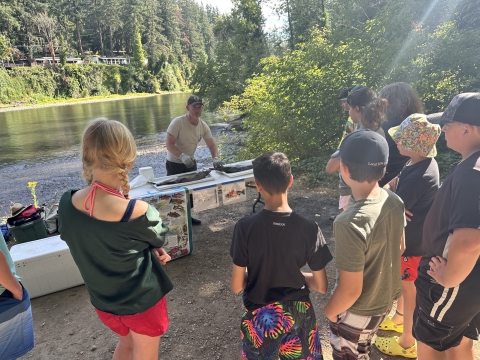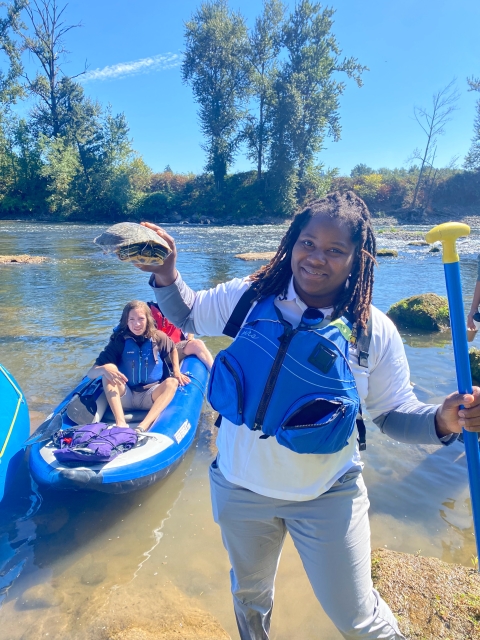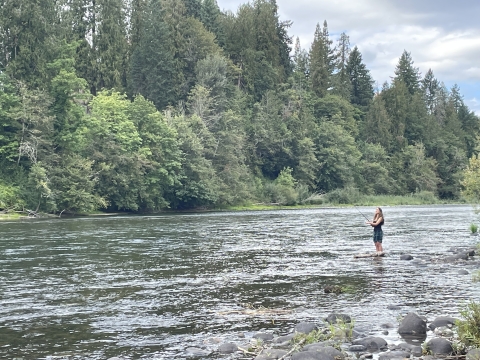"How can I get a job working for your agency someday?"
If you're in the business of educating and engaging people, particularly young adults, with the species and habitats we are entrusted to protect, restore, and enhance, these words are music to your ears. One of the most rewarding roles many of us have as U.S Fish and Wildlife Service employees is connect people with nature, and share our own expertise and passion with the next generations of conservation professionals.
In August and September 2023, Pacific Region Fish and Aquatic Conservation (FAC) Program staff did just that, bringing nearly 30 youth and adult chaperones on river-float field trips that combined recreation with conservation education. For nearly all participants, it was a series of aquatic and on-the-water 'firsts:' the first time floating a river on a raft, first time casting a fishing pole, first time learning about salmon conservation and meeting a hatchery manager, the first time they had visited a National Fish Hatchery.
With $1,000 national 'Fish Funds' grant, staff from the Pacific Region FAC Program collaborated with Portland area non-profits Clackamas River Basin Council (CRBC) and We Love Clean Rivers to bring students from Springwater Environmental Sciences Middle School and Rosemary Anderson High School on two five-mile river floats along the lower Clackamas River and its newly-minted Water Trail. The original project envisioned one float that would include 6-12 students. Thanks to a We Love Clean Rivers 1:1 funding match, organizers were able to plan two trips and triple the number of participants.
The Clackamas River, one of the cleanest, most accessible and biologically important rivers in the Portland metropolitan area, was chosen as the trips' staging site. Just 30 minutes from downtown Portland, the river provides drinking water to over 300,000 area residents and is one of Oregon's top fishing and recreation destinations.
It's also a multi-use river system where the Service has raised salmon continuously for nearly 70 years, and since 2011 reintroduced and monitored bull trout, a federally-protected species that had largely disappeared from the Clackamas River Basin in the mid 1960s.
A surprisingly high number of residents in communities near or along the Clackamas River don’t know that, however, or how and where to enjoy the Clackamas for recreational boating or fishing. Youth from under-represented backgrounds often face additional barriers to river access that extend beyond basic knowledge of what's happening or where to go, like learning and practicing river safety, access to gear, lack of experiences reinforcing the well-being rivers provide, or feeling physically and psychologically safe on the water.
Kids On The Clackamas set out to overcome these barriers for its students. The schools, though in different locations and with different demographics, share commonalities. One of the biggest? Only 1-2 students had ever floated on a local river or fished in their lives, even though they ranged in age from 13-21. Here's how the two trips unfolded:
Excursion 1: Wednesday, August 9, 2023
The partners and a river rescue-trained technician meet 14 Springwater Environmental Science School students and their chaperone at Carver Park. Students get an overview of the salmon life cycle, see a fish dissection, and get tips on paddling teamwork. The group then floats nearly five miles of the lower Clackamas River, learning about migrating salmon, steelhead trout, bull trout, and Pacific lamprey, and aquatic habitat.
At one moment an osprey dives into the Clackamas and pull out a native trout, then flies directly overhead with the fish flapping in its talons. The group whoops and hollers to show its appreciation for the acrobatics, then several jump into the river in their lifejackets to cool off.
The trip ends at Riverside County Park, marking the first time any of the students had floated on the Clackamas River, even though they live in the watershed and attend a public charter school located next a key Clackamas River tributary. One of Springwater alumns, a high school student, asks about internship programs. Someday, she says, she would love to work for the U.S. Fish and Wildlife Service.
Excursion 2: Wednesday-Thursday, September 6-7, 2023
Service employees and staff from local outfitter eNRG Kayaking lead a group of eight Rosemary Anderson High School students aged 15-21 and three staff through two-days of ‘aquatic conservation education through recreation’ activities. Although most of the students live in north and northeast Portland about 30 minutes away, none have ever been to, let alone floated, the Clackamas River.
While rafting, group learns about Service operations and programs in the Clackamas River Basin: Eagle Creek National Fish Hatchery's hatchery operations and bull trout reintroduction and monitoring efforts. The party also stops at two major CRBC habitat restoration sites established to restore and enhance Pacific salmon, steelhead trout, and Pacific Lamprey. Herons, kingfishers, mergansers, and even a bald eagle fly overhead during the trip.
"It's so peaceful out here," a student reflects.
Another Rosemary Anderson student finds a turtle entangled with fishing line, a hook stuck in its mouth. The 'wildlife rescue' turns into an unscripted lesson on aquatic invasive species when it’s identified as an invasive red-eared slider. Nevertheless, the turtle nearly steals the show for 'most memorable moment' of the trip, and is later handed over to the Oregon Department of Fish and Wildlife for research.
On Thursday, the group returns to the Basin and tours Eagle Creek National Fish Hatchery, where staff give a tour and explain the importance of its coho salmon programs to area tribes and recreational anglers. It is the first time students have ever visited a fish hatchery.
A visit to nearby Bonnie Lure State Recreation Area, and a bankside fishing and angling skills clinic on Eagle Creek, follows. After casting practice everyone hikes to an ongoing large woody debris restoration project and sees how drones are used to assess site suitability for restoration projects and monitor restoration progress.
The students and their Service guides hike to a spot on the Clackamas River about 12 miles upstream from the previous day’s float. There's more time to practice fishing, using methods ranging from live bait to artificial lures to fly fishing. Like all river time, time seems to slow, but goes by fast. As 4pm approaches, even though no one catches anything, the students are reluctant to call 'last cast' and head back to the bus.
This won't be a last time fishing for any of the Rosemary Anderson group that wants to go again, however. Gear has been purchased with the remaining Fish Funds specifically for the school and its outdoor education programs. The Service contributes eight spinning rods, eight fly rods, and tackle boxes to make future fishing excursions possible, leaving the equipment with the chaperones. It's a small contribution, and 'just' one excursion, but like the August trip with Springwater Environmental Sciences School, is also the beginning of what will hopefully be more collaboration and more Service-supported outdoor experiences on the Clackamas or another nearby waterway.
This work was supported by a grant from the Fish and Aquatic Conservation Fish Funds program. Participation in outdoor activities like hunting, fishing, hiking, and birding connect people with nature and empower the next generation of conservationists.


